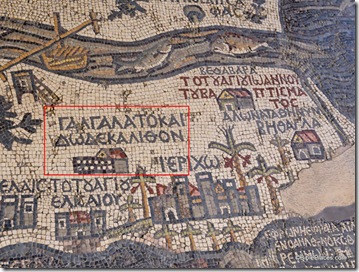Does the newly discovered Roman quarry mark biblical Gilgal? The excavator thinks this is possible. From Haaretz:
Zertal says their working theory is that the site is Galgala, biblical Gilgal, mentioned on the sixth-century Madaba mosaic map. The cave, buried 10 meters underground, is about 100 meters long, 40 meters wide and 4 meters high, is the largest artificial cave so far discovered in Israel.
Potsherds found in the cave and the carvings on the columns led Zertal to date the first quarrying of the cave to around the beginning of the Common Era. It was used mainly as a quarry for 400 to 500 years,” but other finds give the impression it was used for other purposes, perhaps a monastery or even a hiding place,” Zertal said.
Zertal said scholars wondered why people would dig a quarry underground considering the effort needed to just to pull the stones out of the ground.
A possible answer may be in the famous Madaba Map of ancient Palestine, found in Jordan. In it, a place named Galgala is marked and an accompanying Greek word meaning “12 stones.” The map also depicts a church near the site. Archaeologists say they have found two ancient churches near the cave.
According to Zertal, scholars had always assumed that “12 stones” refered to the biblical story of the 12 stones the Israelites set up at Gilgal after they crossed the Jordan.
However, the discovery of the quarried cave may mean the reference was to a quarry established where the Byzantines identified Gilgal. Zertal explains that in antiquity sanctuaries were built out of stones from sacred places.
The rest of the article is here.
I would note that there is sometimes a big difference between a biblical site and what Byzantines thought was a biblical site. In any case, the quarry’s location, 3 miles north of Jericho, is approximately where biblical scholars have supposed ancient Gilgal may have been located. What has always been lacking is any archaeological evidence for a site from the time of Joshua. A Roman quarry does not provide that evidence, but it may be a step in the right direction.
References to Gilgal in the Bible include Josh 4:19-20, Josh 10:6-7, 1 Sam 11:14-15, 1 Sam 13:4-15, 2 Sam 19:15; 2 Kings 2:1, Hos 4:15, and Amos 4:4.
HT: Joe Lauer
UPDATE (6/22): Thanks to Joe Lauer for sending along links to articles with photos. The University of Haifa has issued a press release which includes four high-resolution photos. Ynet includes a slideshow with six images, including one of the cave’s entrance.
UPDATE (6/25): National Geographic has an article about the discovery, including some quotations from Jodi Magness.
 Jericho and Gilgal on the Medeba Map
Jericho and Gilgal on the Medeba Map Outlined in red is “Gilgal, also the Twelve Stones”
Below and to the right is the city of “Jericho,” surrounded by palm trees
The Jordan River is at the top, with the fish on the right swimming away from the Dead Sea
For more about the Medeba Map, see this BiblePlaces page.
5 thoughts on “Roman Quarry = Ancient Gilgal?”
How far is this quarry from Kh Samra, long identified as the source for many of the sandstone ashlars, column drums and capitals at e.g. Masada, Qumran and Rujm el Bahr?
David Stacey
David – I haven't seen specifics about exactly where this site is other than 4 km north of Jericho. As you know, Jericho is quite large, so I don't know if they're measuring from downtown or the northern end. In any case, Khirbet Samarat is not more than 5 miles away.
What about the quarries near Jericho that are mentioned in Judges when Ehud killed Eglon? It mentions the quarries that were by Gilgal. Is this the same place?
Lisa – perhaps. I think the problem is that the evidence reported dates the quarries to about 1300 years after the time of Ehud.
The Greek doesn't say "Galgala and the Twelve Stones" but "Galgala and the Twelve-Stone Thing," which connotes some construction notable for twelve stones incorporated in it. The illustration makes it look like a dark-stoned wall of some sort with lighter stones incorporated in it. I wonder if there's any mention about this Dodekalithon anywhere. I'll have to take a look. Very interesting.